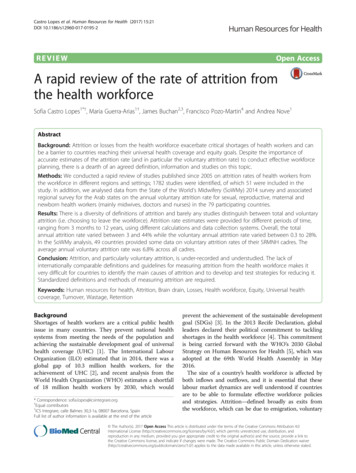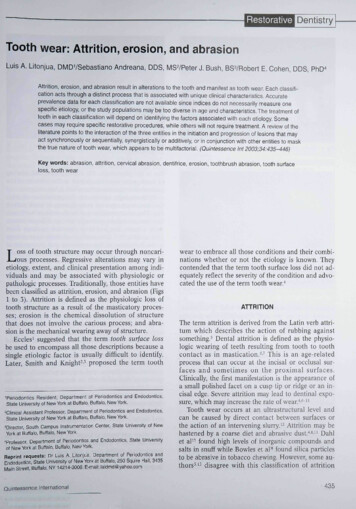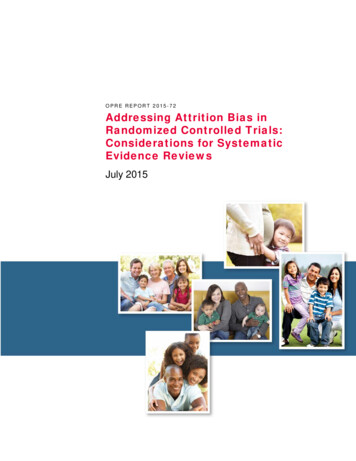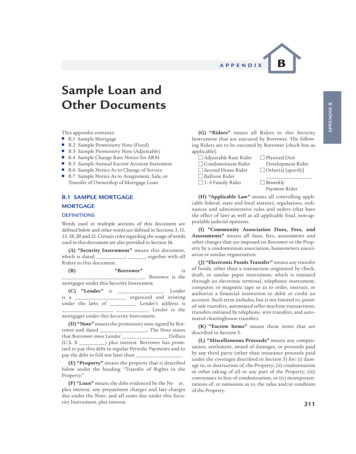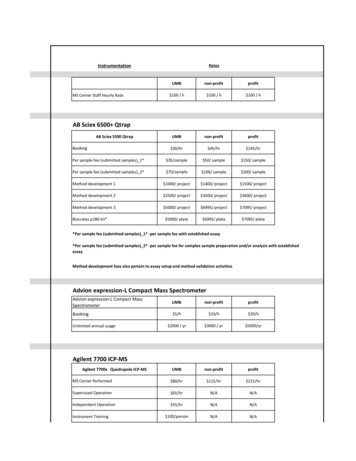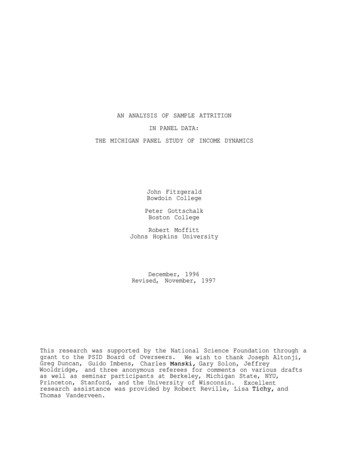
Transcription
AN ANALYSIS OF SAMPLE ATTRITIONIN PANEL DATA:THE MICHIGAN PANEL STUDY OF INCOME DYNAMICSJohn FitzgeraldBowdoin CollegePeter GottschalkBoston CollegeRobert MoffittJohns Hopkins UniversityDecember, 1996Revised, November, 1997This research was supported by the National Science Foundation through agrant to the PSID Board of Overseers. We wish to thank Joseph Altonji,Greg Duncan, Guido Imbens, Charles Manski, Gary Solon, JeffreyWooldridge, and three anonymous referees for comments on various draftsas well as seminar participants at Berkeley, Michigan State, NYU,Princeton, Stanford, and the University of Wisconsin. Excellentresearch assistance was provided by Robert Reville, Lisa Tichy, andThomas Vanderveen.
AbstractAn Analysis of Sample Attrition in Panel Data:Michigan Panel Study of Income DynamicsBy 1989 the Michigan Panel Study on Income Dynamics (PSID) hadexperienced approximately 50 percent sample loss from cumulativeattrition from its initial 1968 membership.We study the effect of thisattrition on the unconditional distributions of several socioeconomicvariables and on the estimates of several sets of regressioncoefficients.We provide a statistical framework for conducting testsfor attrition bias that draws a sharp distinction between selection onunobservables and on observables and that shows that weighted leastsquares can generate consistent parameter estimates when selection isbased on observables, even when they are endogenous.Our empiricalanalysis shows that attrition is highly selective and is concentratedamong lower socioeconomic status individuals.We also show thatattrition is concentrated among those with more unstable earnings,marriage, and migration histories.Nevertheless, we find that thesevariables explain very little of the attrition in the sample, and thatthe selection that occurs is moderated by regression-to-the-mean effectsfrom selection on transitory components that fade over time.Consequently, despite the large amount of attrition, we find no strongevidence that attrition has seriously distorted the representativenessof the PSID through 1989, and considerable evidence that its crosssectional representativeness has remained roughly intact.
The increased availability of panel data from household surveyshas been one of the most important developments in applied socialscience research in the last thirty years.Panel data have permittedsocial scientists to examine a wide range of issues that could not beaddressed with cross-sectional data or even repeated cross sections.Nevertheless, the most potentially damaging and frequently-mentionedthreat to the value of panel data is the presence of biasing attrition-that is, attrition that is selectively related to outcome variables ofinterest.In this paper we present the results of a study of attrition andits potential bias in one of the most well-known panel data sets, theMichigan Panel Study of Income Dynamics (PSID).The PSID has suffered alarge volume of attrition since it began in 1968--almost 50 percent ofinitial sample members had attrited by 1989.We study the effect ofattrition in the PSID on the means and variances of several importantsocioeconomic variables --such as individual earnings, educational level,marital status, and welfare participation-- and on the coefficients ofvariables in regressions for these variables.We also examine whetherthe likelihood of attrition is related to past instability of suchbehaviors-- earnings instability, propensities to migrate or to changemarital status, and so on.A companion paper studies the effect ofattrition on estimates of intergenerational relationships (Fitzgerald etal., 199733).An understanding of the statistical issues is important tounderstanding our approach.We provide a statistical framework for theanalysis of attrition bias which shows that the common distinctionbetween selection on unobservables and observables is critical to the
development of tests for attrition bias and adjustments to eliminate it.However, we show that selection on observables is not the same asexogenous selection, for selection can be based on endogenousobservables such as lagged dependent variables which are observed priorto the point of attrition.We note that the attrition bias generated bythis type of selection can be eliminated by the use of weighted leastsquares, using weights obtained from estimated equations for theprobability of attrition, and hence without the highly parametricprocedures used in much of the literature.Many of our tests forattrition bias are consequently based on whether lagged endogenousvariables affect attrition rates.However, we also conduct an implicittest for selection on unobservables by comparing PSID distributions withthose from an outside data source, the Current Population Survey (CPS).We find that while the PSID has been highly selective on manyimportant variables of interest, including those ordinarily regarded asoutcome variables, attrition bias nevertheless remains quite small inmagnitude.The major reasons for this lack of effect are that themagnitudes of the attrition effect, once properly understood, are quitesmall (most attrition is random); and that much attrition is based ontransitory components that fade away from regression-to-the-mean effectsboth within and across generations.We also find that attrition-adjusted weights play a small role in reducing attrition bias. Weconclude therefore that the PSID has stayed roughly representativethrough 1989.l1A similar conclusion was reached by Becketti, Gould, Lillard,and Welch (1988) for the PSID using data through 1981 (see also Duncanand Hill, 1989, for an analysis of representativeness in 1980).2
I. The PSID: General Attrition PatternsThe PSID began in 1968 with a sample of approximately 4800families drawn from the U.S. noninstitutional population (for a generaldescription of the PSID see Hill, 1992).Since 1968 families havebeen interviewed annually and a wide variety of socioeconomicinformation has been collected.Adults and children in the originalPSID households or who are descendents of members of those householdsare followed if they form or join new households, thereby providing thesurvey the possibility of staying representative of the nonimmigrantU.S. population.A consequence of the self-replenishing nature of thepanel is that the sample has grown in size over time. There wereapproximately 18,000 individuals in the 1968 families; by 1989,information on about 26,800 individuals had been collected.'About three-fifths of the 1968 families were drawn from arepresentative sampling frame of the U.S. called the "SRC" sample, andtwo-fifths were drawn from a set of individuals in low-income families(mostly in SMSAs) known as the "SEO" sample. At the time the surveybegan, the PSID staff produced weights that were intended to allow usersto combine the two samples and to calculate statistics representive ofthe general population.Those sample weights have been periodicallyupdated to take into account differential mortalityas well asdifferential attrition (see Institute for Social Research, 1992, pp.822Institute for Social Research (1992, Table 14). The PSID alsointerviews individuals who are not related to a 1968 family but who moveinto interviewed households, most commonly by marrying a PSID member.Those individuals are termed "nonsample" observations and are assigned azero weight. Another 11,600 of these individuals had been interviewed by1989, on top of the 26,800 mentioned in the text. Generally, suchindividuals are no longer interviewed if they leave a PSID household.However, all children of a "sample" parent and "nonsample" parent arekept in the survey, which causes the PSID sample size to grow over time;see below.3
98 for a recent discussion of nonresponse and other weightingadjustments).We shall discuss the effect of this weight adjustment inour paper.Table 1 shows response and nonresponse rates of the original 1968sample members.3The first three columns in the table show the numberof individuals remaining in the sample by year---the number in a familyunit, the portion in institutions-- whom we treat as respondents, to beconsistent with practice by PSID staff--and their sum, equal to 18,191individuals in 1968.As the table indicates in the fourth column, about88 percent of these individuals remained after the second year, implyingan attrition rate of 12 percent.The actual number attriting is shownin the fifth column, with conditional attrition rates shown inparentheses below each count.A smaller proportion left the PSID ineach year after the first--generally about 2.5 or 3.0 percent annually.By 1989, only 49 percent of the original number were still beinginterviewed,corresponding to a cumulative attrition rate of 51 percent.The table also shows the distribution of the attritors by reason-either because the entire family became nonresponse ("family unitnonresponse"), because of death, or because of a residential move whichcould not be successfully followed.4The distribution of attrition byreason has not changed greatly over time, although there is a slightincrease in the percent attriting because of death and a slightreduction in the percent attriting because of mobility. Both of these3These attrition rates condition on being interviewed in 1968,the initial year. However, only 76 percent of the families selected tobe interviewed were interviewed (Hill, 1992, p.25). We return to thisissue below in our comparisons with the CPS.4 Some of the "family unit nonresponse" observations may haveattrited because of migration or mortality unknown to the PSID.4
trends are no doubt a result of the increasing age of the 1968 sample.The final column in the table shows the number of individuals who cameback into the survey from nonresponse ("In from nonresponse") each year.These figures are quite small because, prior to the early 199Os, thePSID did not attempt to locate and reinterview attritors.Figure 1 illustrates the overall attrition hazards graphically.The Figure clearly shows the spike in the hazard in the first year. Itis also more noticable in the Figure that there has been a slight upwardtrend in attrition rates over time, although not large in magnitude.In a background report (Fitzgerald et al., 1997a), we showcumulative rates of response among 1968 sample members by race, sex, andage.Cumulative nonresponse rates have been highest for races otherthan black and white, and next highest for blacks.are higher among men than among women.Nonresponse ratesNot surprisingly, nonresponserates are highest among the older 1968 sample members and amongrespondents initially between 16 and 24.Among the oldest 1968 samplemembers, those 65 and over, only 7 percent were interviewed in 1989.Nonresponse rates are also higher in the SE0 subsample than in the SRCsubsample although not by a large amount.That mortality should have a marked effect on the measuredresponse rate is not surprising, but it does imply that the 51-percentattrition rate in Table 1 overstates sample loss among the livingpopulation.When individuals who died while in the PSID are excluded,overall nonresponse rates fall from 51 percent to 45 percent overall andfrom 68 percent to 47 percent among those 55-64.When an additionaladjustment is made for mortality among attritors after the point ofattrition (using national mortality rates by age, race, and sex), theattrition rate for the older population falls another 12 percentage5
points to 35 percent and the overall attrition rate falls to 44 percent(i.e., the estimated percents of still-alive individuals who have leftthe PSID).5II. Statistical ApproachAlthough a sample loss as high as 44 percent must necessarilyreduce precision of estimation, there is no necessary relationshipbetween the size of sample loss from attrition and the existence ormagnitude of attrition bias.Even a large amount of attrition causes nobias if it is "random" in a sense we will define formallybelow.Inthis section we will outline our approach to addressing this issue bypresentinga statisticalmodel that distinguishes between differenttypes of bias, which discusses the different restrictions necessary todetect and correct for each type, and which outlines which types we willaddress in our empirical work.Selection on Observables and Unobservables.Attrition bias in theeconometric literature is associated with models of selection bias, andthe applicability of the selection bias model to attrition wasrecognized early in the literature (e.g., Heckman, 1979).Butrecognition of the problem of nonresponse and the bias it can causedates from much earlier in the survey sampling literature (see Madow etal., 1983, for a review).Here we will present a model tied more5That is, individuals who died after the point of attritioncannot be identified as having died from the PSID data. This impliesthat the attrition rates we have calculated, even netting out those whodied while in the PSID, overstate the fraction of the living populationthat has attrited. We use national mortality rates by age, race, sex,and year to estimate the number of attritors who have died, and thenrecalculate our attrition rates accordingly.6
closely to econometric formulations than to those in survey samplingstudies.Our setup will initially be formulated as a cross-sectionmodel but then will be modified for panel data.We assume that the object of interest is a conditional populationdensity f(ylx) where y is a scalar dependent variable and x is (forillustration) a scalar independent variable.We will work at thepopulation level and ignore sampling considerations.Define A as anattrition dummy equal to 1 if an observation is missing its value of ybecause of attrition and 0 if not (we assume for the moment that x isobserved for all, as would be the case if it were a time-invariant orlagged variable).density g(ylx,A O).We therefore observe (or can estimate) only theThe problem is how to infer f from g.By necessitythis will require restrictions of some kind.Although there are many restrictions possible (in fact, aninfinite number), we will focus only on a set of restrictions which canbe imposed directly on the attrition function, which we define as theHere z is an auxiliary variableprobability function Pr(A Oly,x,z).which is assumed to be observable for all units (e.g., a time-invariantor lagged variable) but distinct from x, and whose role will becomeclear momentarily.The variable y is partially unobserved in thisfunction because it is not observed if A l.The key distinction we make is between what we term selection onobservable8 and selection on unobservables.6We say that selection on6 These terms have not, to our knowledge, been utilized in theliterature on sample selection models (i.e., models where a subset ofthe population is missing information on y). However, the terms havebeen used in the treatment-effects literature, most extensively andexplicitly by Heckman and Hotz (1989) but also by Heckman and Robb(1985, p.190). The concept of selection on observables, if not theexact term, appears much earlier in the treatment-effects literature.We should also note that the survey sampling literature often uses the7
observables occurs whenPr(A Oly,x,z ) Pr (A Olx,z)(1)We say that selection on unobservables occurs simply when (1) fails tohold; that is, when the attrition function cannot be reduced fromPr(A Oly,x,z).'These definitions may be more familiar when they are restatedwithin the textbook parametric model.Letting E( x) ,x andPr(A 01x,z) F(-60-61x-62z), where F is a proper c.d.f., we can state themodel equivalently with error terms e and v asY p, p,x eI y observed if A 0A* 6 0 alx 622 vA l ifA* 0(2)(3)(4)ifA* Owhere v is the random variable whose c.d.f. is F. In the contextof this model, selection on unobservables occurs whenZIElXbutV-La I x(5)and that selection on observables occurs whenterms "ignorable" and "missing-at-random" selection to describe what weare terming selection on observables (Little and Rubin, 1987).7We could define selection on unobservables to occur when x and zdrop out of the probability function, and then to define selection onboth observables and unobservables to occur when y,x, and z all appearin the function, but we are not particularly interested in the formercase and hence will not maintain such usage.8
Vbut z -11 e 1 xI&(6)where the symbols 11 and 71 denote "is independent of" and "is notindependent of," respectively. The selection on observables case isrelatively unfamiliar in the econometrics literature but we will showthat it is relevant for the attrition problem.However, we will firstdeal with the more familiar case of selection on unobservables.Selection on Unobservables. We will discuss this model onlyExclusion restrictions are thebriefly because of its familiarity.usual method of identifying this model, and our major goal here is todiscuss the difficulty in finding such restrictions for a nonresponsemodel in the PSID.Working from the parametric form of the model, the conditionalmean of y in the nonattriting sample can be writtenE(ylx,z,A O) PO plx E(e x,z,v -60- lx-62z) PO P,xth(-60-61x-52z) PO P,xth'(F(-50-61x-62z)where h and h' are functions with unknown parameters.(7)Moving from thefirst to the second line of the equation requires that the jointdistribution of a and v be independent of x and z, so that theconditional expectation depends on x and z only through the index.Moving from the second to the third line simply replaces the index byits probability, which is permissible since they have a one-to-onecorrespondence.Early implementations of this model assumed a specific bivariate9
distribution for e and v, leading to specific forms of the expectationfunction (e.g., the inverse Mills ratio for bivariate normality), whilemore recent implementations have relaxed some of the distributionalassumptions in the model by estimating functions h or h' whose argumentsare either the attrition index or the attrition probability,respectively (see Maddala, 1983, for a textbook treatment of the earlyapproach and Powell, 1994, pp.2509-2510,recent approach).for discussions of the moreArmed with estimates of the parameters of theattrition index or of the predicted attrition probability, equation (7)becomes a function whose parameters can be consistently estimated.*However, aside from nonlinearities in the h, h', and F functions,identification of p requires an exclusion restriction, namely, that a zexist satisfying the independence property from e and for which a2 isnonzero. Such a variable is often loosely termed an "instrument,"although most estimation methods proposed for eqn (7) do not take atextbook instrumental-variables form.Finding a suitable instrument forunobservable selection is more difficult for the case of nonresponsethan in some other applications because there are few variables thataffect nonresponse that can be credibly excluded from the main equationfor y.While this depends on the specific model under consideration, on* If nonparametric methods are used to estimate h and h', not allof the parameters in p (e.g., the intercept) may be identifiable. Weshould also note at this point that if x is time-varying then it isnecessarily missing for attritors and hence the attrition propensityequation cannot be estimated as we have written it. Additionalassumptions are then required to estimate the model. For example,adding time subscripts, one could assume x(t) ao a x(t-1)ta z u(t), thusletting x be a function of lagged x and z (some di4 ferent z2 could bespecified, alternatively). Substituting this equation for x(t) into theattrition equation would permit estimation provided x(t-1) is availablefor all observations. This procedure, however, introduces anotherpotential source of selection bias from non-independence of u(t) ande(t) 10
a priori grounds personal characteristics such as those generallyincluded in x are unlikely to be promising sources of instrumentsbecause most such characteristics are related to behavior in general andhence to y.More promising are variables external to the individual and notunder his control, such as characteristics of the interviewer or theinterviewing process, or even interview payments.Although we haveproposed no explicit behavioral model of attrition, a natural theorywould be a simple benefit-cost model in which an individual compares thevalue of participating in the survey to the value of not participating.Good interviewers or interviewing conditions lower the cost ofparticipation and interview payments directly increase the value ofparticipation.However, a suitable instrument must vary acrossrespondents, and must vary in a manner independent of y.The staff atthe Institute for Survey Research who have administered the PSID haveassigned interviewers on the basis of respondent characteristics, andhave also varied interviewing conditions (length of interview, in-personvs. telephone, number of callbacks, etc.) entirely and only on the basisof respondent characteristics; consequently there is no exogenouscomponent to the variation intreatment.This rules these variables outas instruments.Moreover, there have also been no exogenous variations ininterview payments over the course of the PSID, for payments have beenadjusted only for inflation over time and vary within year only on thebasis of interview mode.Based on these and other considerations wediscuss in our background report (Fitzgerald et al., 1997a), we concludethat there are no instruments for nonresponse in the PSID which are11
credibly exogenous to behavior in general.'-I-.Although we will therefore not test for selection on unobservablesdirectly, or correct for such selection, indirect tests for selection onunobservables can be conducted whenever an outside data set is availablecontaining validation information. Administrative data on some variables(e.g., earnings) are occasionally available but this is the exceptionrather than the rule, and they are not available for the PS1D.l'However, the Current Population Survey (CPS) is a heavily-used outsidedata set which is a repeated cross section and hence not subject to thesame type of attrition bias as the PSID.The CPS is subject tononresponse itself, but not of the same order of magnitude as the 50percent nonresponse rate in the PSID.ll Hence we will use the CPS as acomparison data set and compare the marginal distributions of variablesin the CPS and PSID to one another as well as regression coefficients.If selection on unobservables is present and it biases the coefficients,for example (see eqn. (7)), estimates from the two data sets will bedifferent.Unfortunately, this method of comparison is useful only forcross-sectionally-defined variables and not for variables which make useof the panel nature of the PSID, and hence does not offer a general' Exclusion restrictions are only one form of information. For anexample of the use of other types of information, see Manski (1994).Fitzgerald et al. (1997a) provide some simple bounds calculations of onetype proposed by Manski.lo See Hill (1992, p.29) and Bound et al. (1994) for a discussionof validation studies using the PSID.11 While the magnitude of nonresponse does not map directly intothe amount of bias, as we noted earlier, it would be unlikely for theCPS to be more biased than the PSID given these differences in theamounts of attrition.12
solution to the prob1em.l'Selection on Observables.As we noted previously, the case ofselection on observables is relatively unfamiliar in the econometricsliterature.Because of this unfamiliarity, and because, unlikeselection on unobservables, it is something we can actually address, wewill discuss it at slightly greater length than we did the previouscase.The critical variable in the selection on observables case is z, avariable which affects attrition propensities but is presumed also to berelated to the density of y conditional on x (i.e., z is endogenous toY) -Such a variable can exist only if the investigator is interested ina "structural" y function which we interpret as a function of a variablex that plays a causal role in a theoretical sense; other variables(i.e., z) do not "belong" in the function.More generally, thissituation will arise whenever the investigator is interested in (say)the expectation of y conditional on x and simply does not wish tocondition on z.In cross-sectional data, for example, the standardMincerian theory of human capital proposes that earnings are a functionof education and experience; other variables which are jointlydetermined with earnings, like occupation and industry, should not beconditioned on to obtain the "correct" estimates.Yet use of any samplethat is selected on the basis of occupation and industry (e.g., onlycertain occupations and industries are included) will clearly bias theestimates of the earnings equation.The variable z is thus an12Imbens and Hellerstein (1996) show that such outside data sets,if taken as 'truth,' can be imposed on the data set of interest (e.g.,the PSID) and can be used to formally test whether the datadistributions in the two data sets are the same. See related work byImbens and Lancaster (1994) and Hirano et al. (1996) along these lines.13
"auxiliary" endogenous variable.As we will discuss below, in the paneldata case, a lagged value of y can play the role of z if it is not inthe "structural" model and if it is related to attrition.In the presence of selection on such an endogenous variable, it iseasy to show that least squares estimation of (2) on the nonattritingsample will generate inconsistent estimates of P and, more generally,that the estimable density g(ylx,A O) will not correspond to thecomplete-population density f(ylx) since the event A 0 is related to ythrough z.Apart from this selection on observables bias, using as muchof the lagged information in the panel as possible helps reduce theamount of residual, unexplained attrition variation left over in thedata, and this will reduce the scope for selection on unobservables.Formally, in the Appendix, we show that, under the selection onobservables restriction given in equation (l), the complete-populationdensity f(ylx) can be computed from the conditional joint density of yand z, which we denote by g:f(YlX) I g(y,zlx,A O) w(z,x) dz(8)wherePr(A Olz,x)w(z,x) Pr(A Olx)are normalized weights.The numerator of (9) inside the brackets is theprobability of retention in the sample and is, in the parametric modeldescribed above, F(-60-51 -62 ).Because both the weights and theconditional density g are identifiable and estimable functions, the14
complete-population density f(ylx) is estimable, as are its moments suchas its expected value (@, p,x in the parametric model).13 Eqn(8) showsthat the complete-population density can be derived by weighting theconditional density by the (normalized) inverse selection probabilities;in the parametric model, it can be shown that this implies that weightedleast squares (WLS) can be applied to eqn(2) using the weights in (9).We should emphasize that the application of WLS in this case isunrelated to the heteroskedasticity rationale appearing in mosteconometrics texts.It is also not in conflict with the conventionalview among many applied economists that survey weights can be ignoredbecause they do not affect the consistency of OLS coefficients, forsurvey weights are often intended only to adjust for sample designswhich have stratified the population or differentially sampled it byvariables that are exogenous.Here, however, selection is indirectly onthe dependent variable, and not adjusting for attrition results in lossof consistency.If z is not a determinant of attrition, the weights in (9) equalone and hence all conditional densities equal unconditional ones and noattrition bias is present.Alternatively, if y and z are independentconditional on x and A O, the density g in (8) factors and it can againbe shown that the unconditional density f(ylx) equals the conditionaldensity, and there is no attrition bias.While these results are relatively unfamiliar in the econometricliterature,they are pervasive in the survey sampling literature, wherethey form the intellectual justification for the construction and use of13As we noted in n.8, if contemporaneous x is unobserved andhence the attrition probability equation cannot be estimated, lagged xor additional z variables are required.15
attrition-based survey weights (Rao, 1963,197s; Little andRubin,1987,pp.55-60).14'15In the econometrics literature, whileweighting formulations are sometimes used as a framework for discussingselection models (e.g., Heckman, 1987), the main point of contact withthe models discussed here is the choice-based sampling literature (fordiscrete y, see Manski and Lerman, 1977, for an early treatment andAmemiya, 1985, for a textbook treatment; for continuous y, see Hausmanand Wise, 1981, Cosslett, 1993, and Imbens and Lancaster, 1996).Thatliterature generally considers estimation and identification in sampleswhich are selected directly on the dependent variable, y; weightedmaximum likelihood or least squares procedures are often proposed to'undo' the disproportionate endogenous sampling.The difference in theattrition case is that selection is on an auxiliary variable (z) and noton y itself; but otherwise the solutions are closely related.1614For an exception, see Cosslett (1993, pp.31-32). In addition,after the first draft of this paper we discovered an independenttreatment of the selection on observables case by Horowitz and Manski(forthcoming), who show that the mean of a function of y can beconsistently estimated with weights of the type we have discussed underthe same restrictions.15We should note that the weights discussed in the surveysampling literature sometimes differ from the weights in our model intwo respects. First, many survey weights-- including t
outcome variables, attrition bias nevertheless remains quite small in magnitude. The major reasons for this lack of effect are that the magnitudes of the attrition effect, once properly understood, are quite small (most attrition is random); and that much attrition is based on transitory components that fade away from regression-to-the-mean effects
